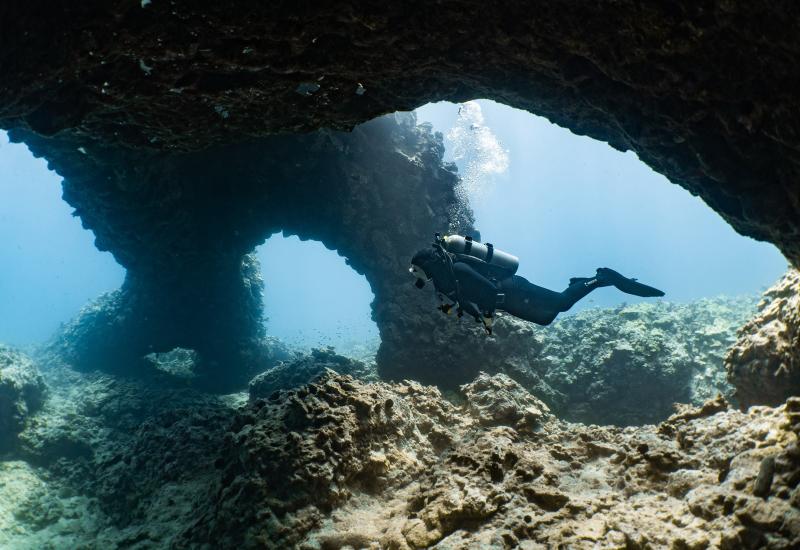A Land-and-Sea Tour of Hawaii's Big Island

Jeffrey MilisenFrom the joyful swooping of manta rays on torch-lit night dives to the vibrant tapestry of wild tropical flowers, the Big Island of Hawai‘i offers endless opportunities for adventure.
“Hawaii was formed by a hotspot. Does anybody know what a hotspot is?”
Shy as I was at age 16, my hand still shot up. My geography teacher nodded for me to respond.
“It’s a place in the Earth’s mantle where heat rises, creating volcanoes and islands as the Earth’s crust moves over it.”
Of course I knew about hotspots. While other South African fathers spent weekends showing their children how to braai our country’s iconic sausage, boerewors or explaining a Springbok rugby game on television, my father was an outlier. A geologist by training, he had an enduring love of the natural world, but more specifically of rocks.
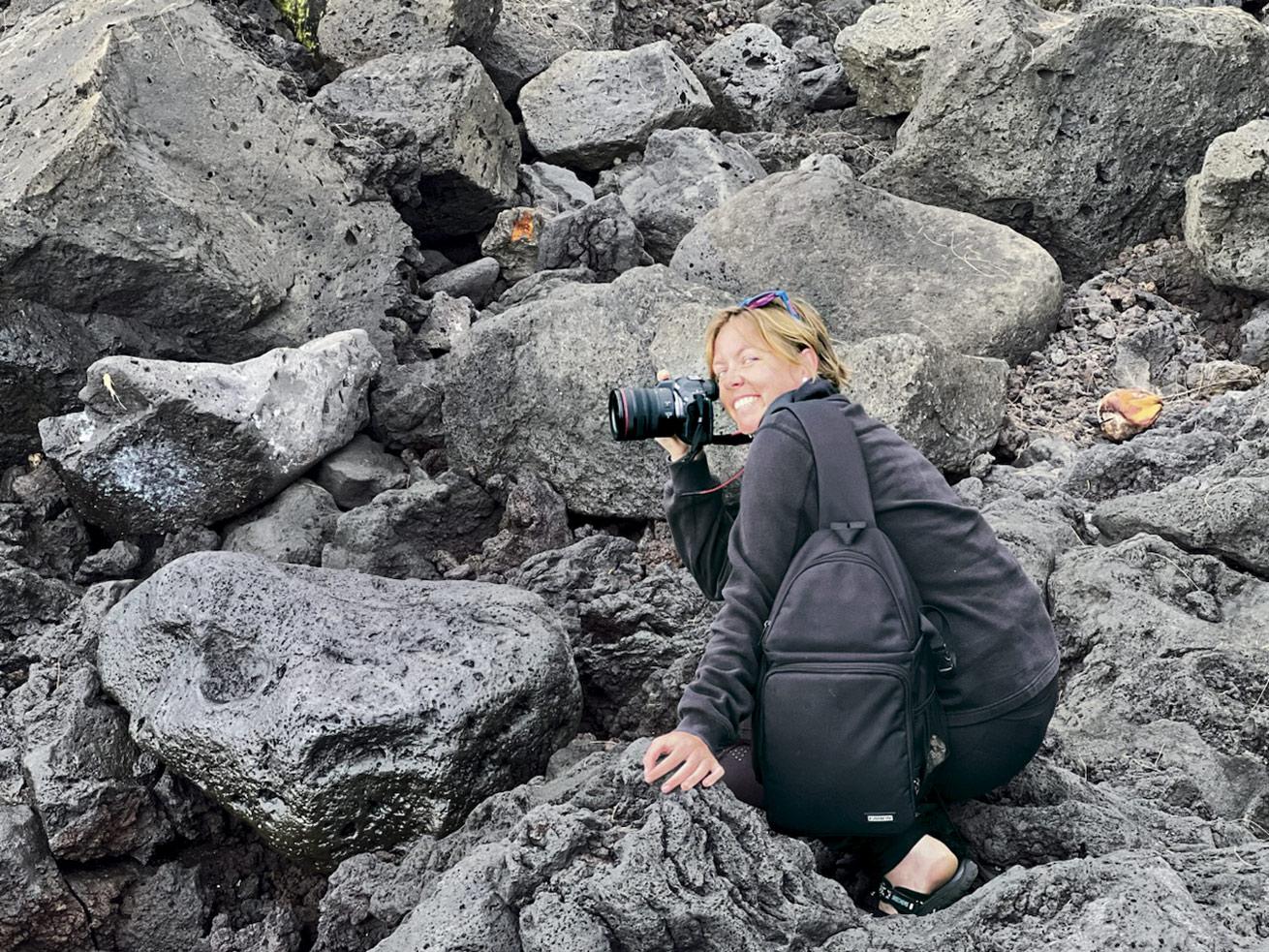
The author captures molten lava at Hawaii Volcanoes National Park.
Outside of Johannesburg, if there is a rock whose crystal structure has not been explained to me, I don’t know it. I’ve been in the Sterkfontein caves, walked the rim of the Vredefort Dome and examined some of the oldest fossilized algae in the world.
Though our lives never took on the easy, carefree aspect we’d imagined they might when we immigrated to the United States, my father’s interest in rocks remained. And so, 20 years later, knowing little about Hawaii, other than it was a hotspot and a dive destination I now had to experience and write about, I sent him an email.
“Happy birthday, Dad. I’ve bought you a ticket to Hawaii. You’re coming on assignment with me!”

A Tropical Paradise
Kailua-Kona does not disappoint, not even from the runway. The view out the airplane window is enough to make both a diver and a geologist’s heart race, an expanse of sun-drenched, coffee-colored lava rubble stretching into the foothills of Mauna Loa, the world’s largest active volcano.
After picking up our rental car, my dad; my boyfriend, Stephen; and I head to our Airbnb. My father lowers the window and inhales the warm salty air. It’s been many years since he last traveled, and I am cheered by his eager interest.
Palm trees and bougainvillea, fig trees and free-roaming chickens. Parts of it remind me of suburban Johannesburg—lush green gardens and hibiscus flowers—while the warm, humid air and turquoise water evoke the Caribbean.
“A tropical paradise,” my dad says as we pull into the driveway of our vacation rental, a spot slightly higher up in the hills on a sprawling coffee farm above Kona with an incredible view.
Later that night, when we meet the owner of the coffee farm, he tells us to walk through the plantation—we might spot chameleons in the trees. While we’re thrilled to hear this, we’re more curious about the nighttime noises.
Once the sun sets, it’s not just the stars that burst into life but also the coqui frog, a small invasive frog that has a call as loud as a cuckoo. The night air is suddenly thick with noise.
Ko-kee, ko-kee, ko-keee.
It sounds without pause, eerily musical, more so even than the crickets and cicadas I’m used to hearing at home in Florida.
Related Reading: Diving for Sunken WWII Relics in Hawaii
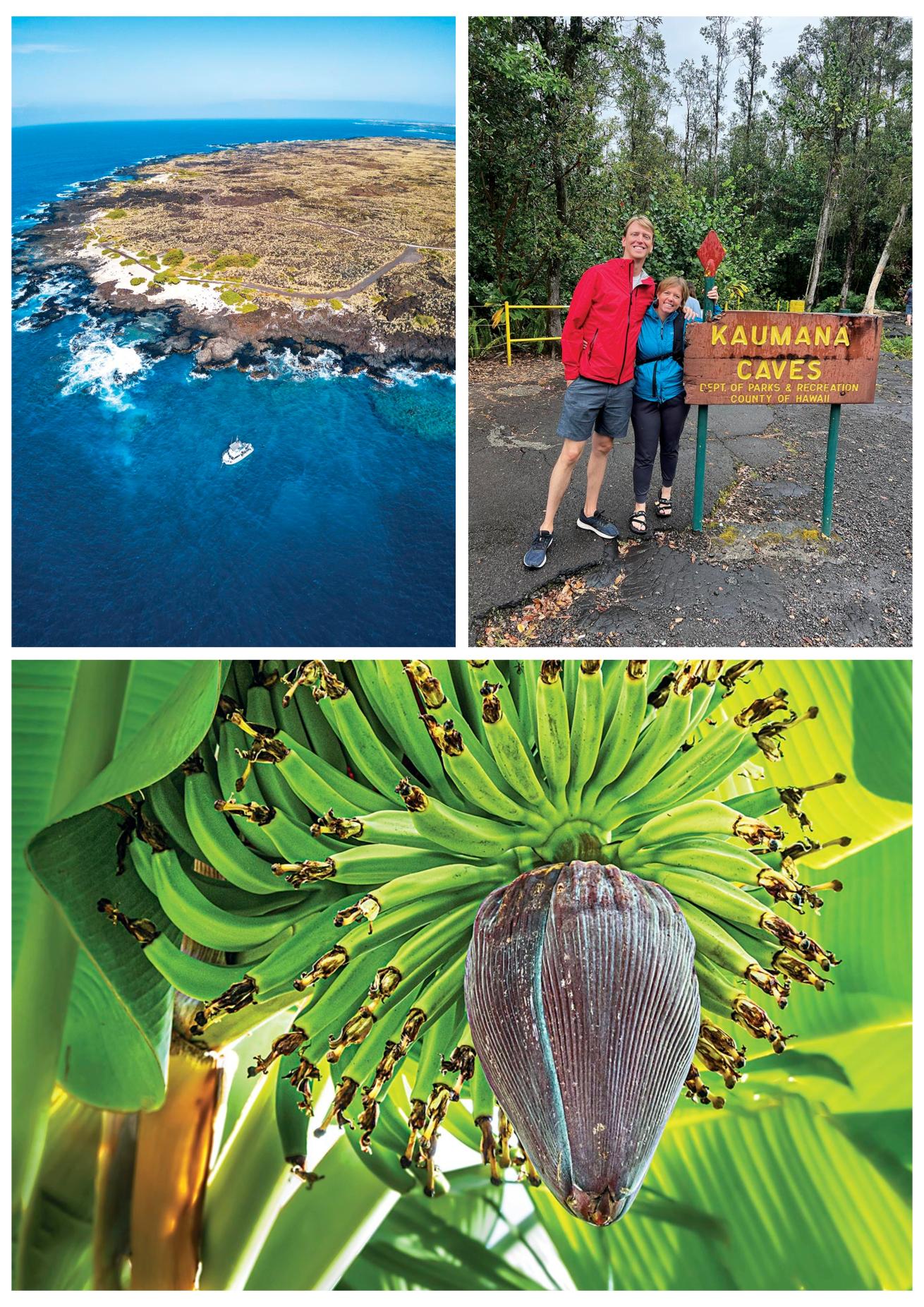
Clockwise: David Fleetham; Chris Landau; Olga TorreyClockwise from top left: Keahuolu Point at Pawai Bay, just north of Kailua-Kona; Candice and Stephen pose for a snapshot at Kaumana Caves near Hilo; a banana flower.
Campfire Tale
By the time I arrive in Hawaii, I’ve been a warm-water diver for only a year. This also means I’ve never seen a manta ray. In spite of this fact, it’s not the dive I’m most excited about. It sounds canned in a Walt Disney World sense. Little do I know that by the end of the night, I’ll find it one of the most enchanting and unforgettable dives of my life.
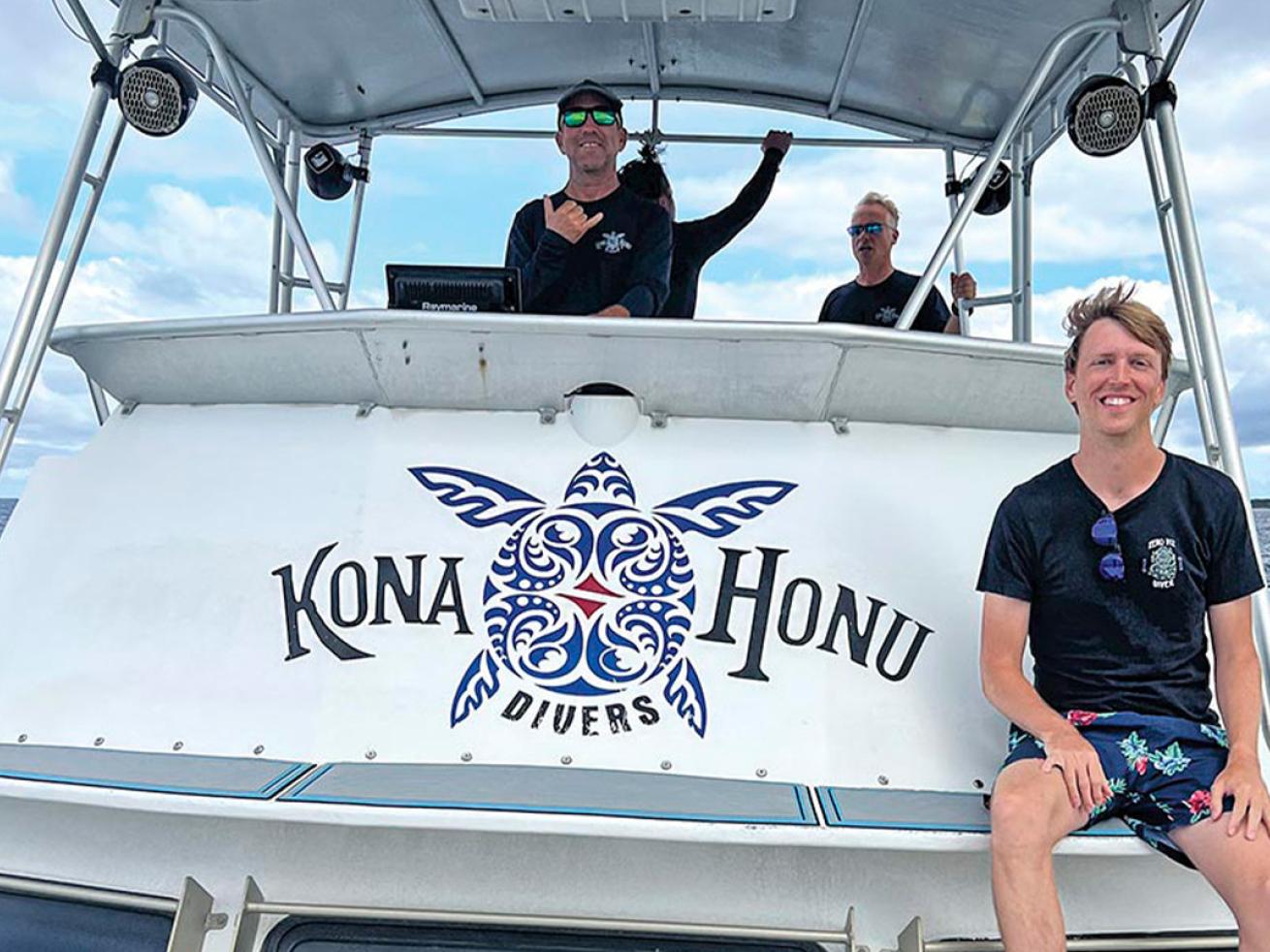
Candice LandauHeading out for a day of diving onboard Kona Honu Divers.
Starting with a pre-sunset familiarization dive at Garden Eel Cove, Kona Honu Divers introduces us to the “campfire” layout—a circle of rocks just 35 feet deep. This is where we will come for our second dive of the evening to watch manta rays swoop overhead. From there we drop down to 70 feet and look out across a sandy bottom bespeckled with garden eels poking their small heads curiously out of their holes, not so different from a field of wafting grass.
The night dive itself is an experience that words barely do justice. I find my throat burns and my eyes well with tears. Gathered under the cloak of darkness around the circle of rocks, holding flashlights above our heads to lure plankton, we watch awestruck as 26 mantas fly and feed above us. Their joyful engagement with the bubbles, their flips and whirls, the way they follow us back to the boat at the end of the evening—everything about this experience shatters my preconceived notions and has me longing for a third dive.

Jason Sintek
Luckily, I get the opportunity toward the end of the week when I do the same dive with a different operation, Jack’s Diving Locker. Keller Laros, or Manta Man, as he is best known, gives a humorous and educational briefing. We learn that no two mantas have the same markings and that if you identify a new one, you get to name it. We also pose for sunset photos just as the sun is setting, the sky a swath of pink, orange and yellow. I find myself wishing I’d coaxed my father into doing the manta night snorkel.
Related Reading: Do Dive Lights Harm Manta Rays?
Stay Connected! Keep up to date with the latest in diving and underwater adventure. Join PADI Club today for access to exclusive events, dive meetups and a subscription to Scuba Diving magazine.

Jason SintekDivers gather around in a circle with strong lights, similar to a campfire setting, to attract manta rays.
Worth the Walk
Eager to get my dad in the water, Stephen and I hunt down a beach known for its excellent snorkeling, scenic views and history. We are, admittedly, less prepared for it than we realize. Though the hike is just 4 miles round-trip, the humidity and the shadeless trail make the day feel hotter than it is. Goats graze in the long brown grass alongside the path, and tamarind trees dotted here and there offer brief respite for anyone who enjoys their sweet-sour fruit or who needs a canopy of shadow.
By the time we get to the bottom, our knees ache and we’re prickly with sweat, desperate to clamber over the rocks and into the water. I hand my dad a snorkel and a mask and send him and Stephen off while I guard our snacks and bags from the mongoose that slips out of the rocks in search of easy pickings.
I spend a few moments watching them pike-dive before returning my attention to land. There’s a gleaming white 27-foot-high obelisk here. It’s supposed to be where British explorer Capt. James Cook met his death in 1779.
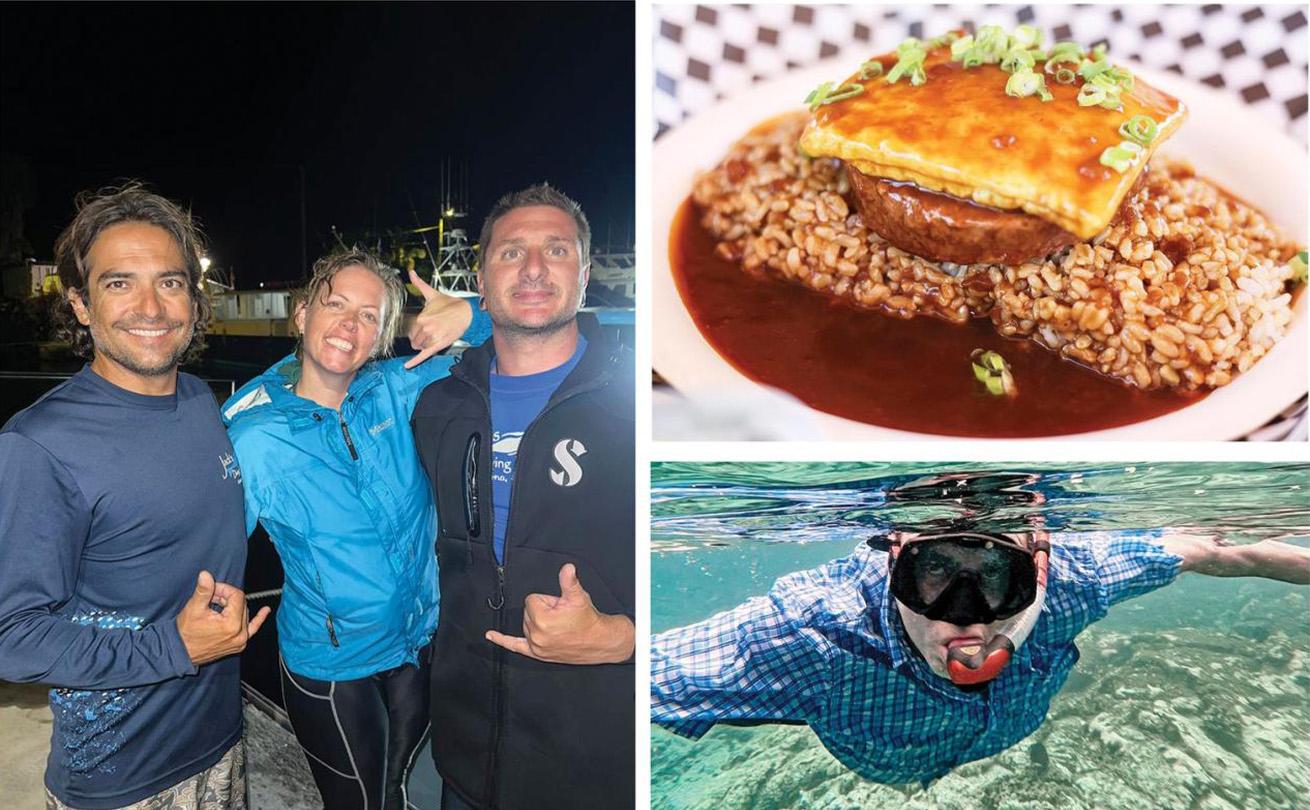
Clockwise from left: Stephen Gee; Candice Landau (2)Clockwise from top: A delicious meal from Herbivores; Candice’s father tries snorkeling; posing after a blackwater dive with Jack’s Diving Locker crew.
When it’s my turn to snorkel, I am struck by the number of fish at this site. Yellow tang, black triggerfish with rippling fins, trumpetfish and a panoply of butterflyfish. They move in rhythm, rising and falling in the gentle surge, the reef cracking in the background, a symphony of peace. I am as awed by this experience as I was when I first dipped my head below the surface and learned to dive.
Though the hike back takes infinitely longer and requires many stops, we feel we deserve our dinner and we return for the third time to Herbivores Vegan Cafe, our favorite eatery on the island.

David FleethamDolphins play in the water off the coast of Kona, Hawaii.
Light in the Dark
I won’t lie, I’m terrified to do the blackwater dive. Knowing I’ve committed to do it twice—once with Kona Honu Divers and once with Jack’s Diving Locker—does little to assuage my concern of dangling over 4,000 feet of pitch-black ocean like a piece of bait on a fishing line.

Simone MatucciAn octopus poses on a blackwater dive, mesmerizing colors on full display.
Divers who have participated in a blackwater dive have differing opinions on how it’s best done, either tethered to the boat or free swimming with a reference point. I’m personally relieved to find we’ll be tethered as it allows me to focus on photographing the tiny critters that rise out of the depths at night rather than anxiously watching how far from the boat I’ve drifted.
The first time I do this dive, I’m lucky enough to have Jeff Milisen, author of A Field Guide to Blackwater Diving in Hawai‘i, on the boat, as well as his wife, Sarah, who gives a thorough and interesting briefing on this type of diving, using a flipchart to show us what we might see. In both cases, we get our gear ready and wait for the sun to set before we motor into the dark, all of the boat’s lights turned off.
The dive itself is otherworldly, and I find myself only occasionally glancing into the dark on the lookout for a shark. I’m already a fan of the microscopic world, so these small critters have my attention the moment they drift into our light beams—glittering ctenophores and small jellies, a venus girdle coiled in mathematical perfection, salps covered in plankton, and fish in their larval phase, almost unrecognizable in comparison to their adult form.

Jeffrey MilisenDivers can witness squid cannibalism during an adventurous night dive.
The second time I do this dive, it’s with Jack’s Diving Locker. Our photographer and guide, Simone Matucci, does a great job critter spotting for me. He points out the tiniest squid as well as an equally tiny seahorse that is happy to give me some sideeye while I figure out how to use my TG-6 camera in the pitch dark. I’m harassed by a tiny squid and baffled by a net caster—a delicate web of fine tentacles that hovers alongside an equally incomprehensible blob of what I later learn to be a radiolarian, a sort of gel-like goo composed of individual cells that looks more like frog spawn.
Natural Beauty
Before we set out on the two-hour drive from Kona to Hawai‘i Volcanoes National Park, we make a pit stop at HiCO Coffee, where I try a purple ube latte and their spicy vegan musabi. Both are a decadent delight. On the way to the park, we make three more stops: a fruit stand, Pu‘uhonua o Hōnaunau National Historical Park and Punalu’u Beach. The historical park gives us our first insight into the archaeology and history of local Hawaiian culture, and the beach our first taste of black lava sand.

David FleethamLava reaches the ocean at Hawai‘i Volcanoes National Park.
By the time we get to Volcanoes National Park, we only have half a day to explore, and as we drive to our first landmark, a huge area of steaming vents, we all agree to return the following day.

Candice LandauCandice’s dad descends into one of Hawaii’s many lava tubes.
There’s simply too much to see. The park is covered with a beautiful red flower that grows on the ‘Ōhi‘a Lehua tree. It and the vents are possibly my favorite sights, though the many craters dotted about the park are impressive too.
The following day we return and take the short hike out to see the Pu’uloa petroglyphs. My father and I spend some time arguing about how and why they were made even though the signposts explain what each means—a dot to signify a child, a jagged line to mean lizard and so on.
Our final stop is a sea arch that requires a short hike down a paved road and through some brush dotted here and there with flowers that I recognize from South Africa. Standing against the backdrop of crashing waves, it’s a powerful reminder of nature’s ability to sculpt and shape the landscape over millennia. “Nature’s own artwork,” my dad says.
Related Reading: Expert Alex Mustard Shares His Secrets on How to Photograph Dolphins in the Wild

David Fleetham
Something for Everyone
The diving in Hawaii is perfect both for novice and experienced divers, with unique geological formations at most sites, including lava tubes and steep dropoffs, cave-like swim-throughs and many opportunities to spot endemic fish like Hawaii’s famous reef triggerfish, locally known as humuhumunukunukuapua’a, as well as sea turtles and dolphins.
One of my favorite dives happens on the last day at a site called Big Arch. I find four different species of nudibranch, as well as multiple eels, two octopuses, and of course, another species endemic to Hawaii, the Hawaiian lionfish, which has a slightly green color, not to be confused with the invasive version we now find in the Caribbean.
A Different Side of the Island
If you’re heading to Hawaii, don’t skip Hilo. Where Kona is hot and humid, Hilo is cooler, forested and dramatic, with caves, waterfalls and swooping valleys and ravines at every turn.
Though our focus for the day is to venture out and experience Kaumana Caves and Rainbow Falls, we are pleasantly sidetracked by the Hawaii Tropical Bioreserve and Garden. I’ve never seen more exotic flowers or such diversity in tropical plants. The lookouts over the ocean are wild and raw, and the garden itself is well signposted and numbered.

Olga Torrey
Kaumana Caves is also an immediate adventure. Within minutes of entering, my father has hit his head on the lava roof and second-guessed entering the long lava tunnel that admittedly isn’t the easiest walking terrain. I find myself wishing I’d brought a dive light with me, as the light from my phone is meager. Stephen and I venture a short way down the tunnel before deciding that it all looks the same.
Rainbow Falls is a striking contrast to the dark, enclosed spaces of the caves. Here, water cascades 80 feet over a natural lava cave, creating a vibrant rainbow in the morning mist. I take at least 50 photos.
Not Just for Divers
There are few places I can say I’d return to in a heartbeat—after all, there’s always more to see—but Hawaii is now one of them. It isn’t even just for the diving. It’s because the island itself is so interesting and varied, both in terms of scenery and activities. It’s truly got something for everyone: the avid outdoors lover, the tiki-bar hopper, the wandering wastrel, the whole family. Until next time, Hawai‘i, aloha.
Need To Know
Dive Operators
Jack’s Diving Locker (jacksdivinglocker.com) Kona Honu Divers (konahonudivers.com)
Conditions
Hawaii’s dive sites feature crystal-clear waters, with visibility often exceeding 100 feet and water temperatures ranging from 75°F in winter to 80°F in summer, making for comfortable diving year-round.
When to Visit
The best time to dive in Hawaii is between April and October, when the seas are calmest, though diving is excellent year-round due to Hawaii’s tropical climate.
Travel Tips
Book your accommodations and car rentals well in advance, especially if visiting during peak tourist seasons or around major holidays, and consider eco-friendly tour operators to help preserve Hawaii’s delicate marine ecosystems.
Recommended Certifications
While open water certification is sufficient for many sites, Advanced Open Water Diver or specialty certifications like Deep Diver or Enriched Air (Nitrox) Diver can enhance your experience. There are also specialty certifications, such as the PADI Pelagic Magic Diver Specialty, or the PADI Manta Ray Diver Specialty, both offered by Jack’s Diving Locker.


